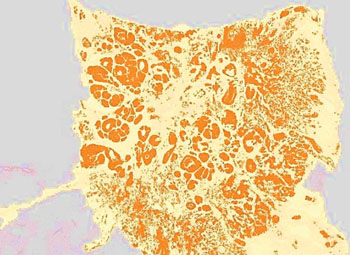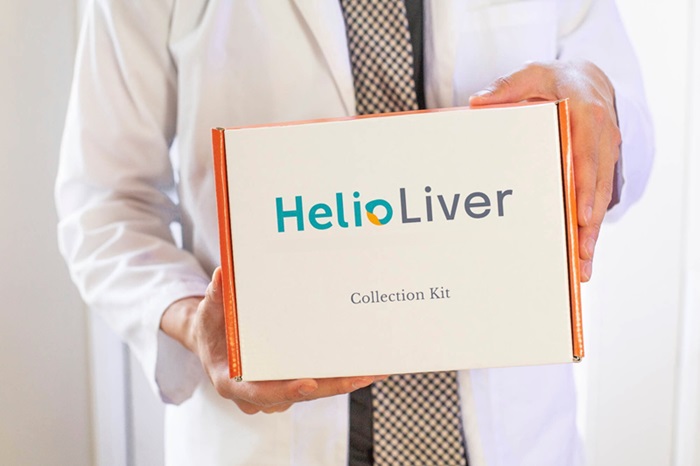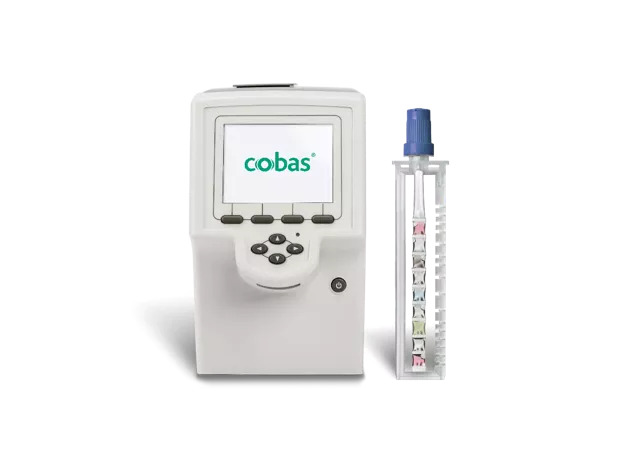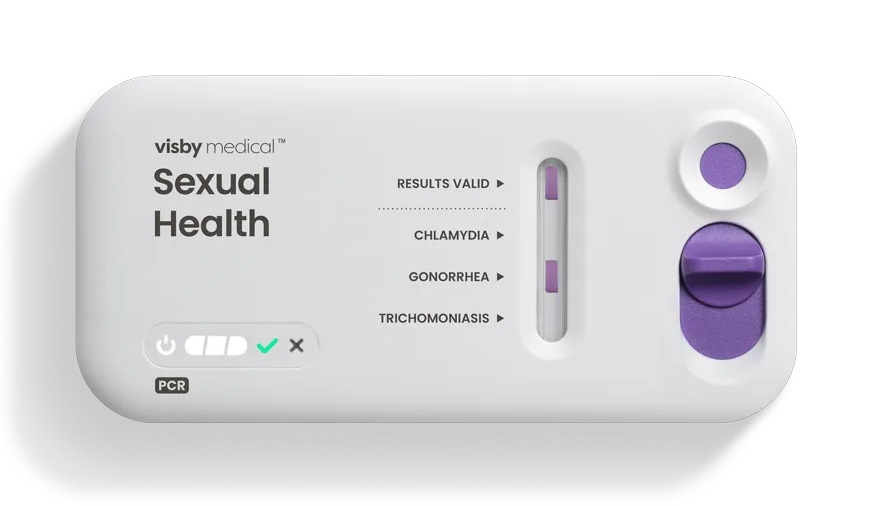Biomarker Reveals Cause of Papillary Thyroid Carcinoma
|
By LabMedica International staff writers Posted on 26 Oct 2014 |

Image: Tumor cell populations identified using digital image analysis from a stained pathology slide, with the tumor regions detected and now colored orange (Photo courtesy of Definiens).
The expression of the CAP-GLY domain containing linker protein 2 (CLIP2) provides information on whether a papillary thyroid carcinoma was induced by radiation or had a sporadic origin.
The biomarker CLIP2 serves as a radiation marker because after exposure to radiation from radioiodine, both the genetic activity and the protein expression are increased especially among children exposed to the radioiodine fallout and have developed papillary thyroid carcinoma (PTC).
Scientists at the Helmholtz Zentrum München (Neuherberg, Germany), and their international colleagues, studied PTCs from a cohort of young patients exposed to the post-Chernobyl radioiodine fallout at very young age and a matched non-exposed control group. They investigated the potential role of CLIP2 as a radiation marker to be used for the individual classification of PTCs into CLIP2-positive and -negative cases, a prerequisite for the integration of CLIP2 into epidemiological modelling of the risk of radiation-induced PTC. A discovery cohort of 33 individuals and two independent validation cohorts of 115 PTCs were investigated.
The team were able to validate the radiation-associated CLIP2 overexpression at the protein level by immunohistochemistry (IHC) followed by relative quantification using digital image analysis software (Definiens AG; Munich, Germany). They analyzed the function of CLIP2 in radiation-associated PTC, by reconstructing the CLIP2 gene regulatory network using global messenger ribonucleic acid (mRNA) expression data from PTC patient samples. The genes comprising the first neighborhood of CLIP2, BCL2-associated athanogene 2 (BAG2), carbohydrate (chondroitin 6) sulfotransferase 3 (CHST3), kinesin family member 3C (KIF3C), neuralized E3 ubiquitin protein ligase 1 (NEURL1), peptidylprolyl isomerase (cyclophilin)-like 3 (PPIL3), and regulator of G-protein signaling 4 (RGS4) suggest the involvement of CLIP2 in the fundamental carcinogenic processes including apoptosis, mitogen-activated protein kinase signaling and genomic instability.
Julia Hess, MD, the senior author of the study said, “CLIP2 serves as a radiation marker and allows us to distinguish between radiation-induced and sporadic thyroid carcinomas. This biomarker allows us both to draw conclusions about the mechanisms involved in the development of such tumors and to evaluate the risk of thyroid cancer after exposure to high level radiation, for instance, following a radiation accident.” The study was published on October 6, 2014, in the journal Oncogene.
Related Links:
Helmholtz Zentrum München
Definiens AG
The biomarker CLIP2 serves as a radiation marker because after exposure to radiation from radioiodine, both the genetic activity and the protein expression are increased especially among children exposed to the radioiodine fallout and have developed papillary thyroid carcinoma (PTC).
Scientists at the Helmholtz Zentrum München (Neuherberg, Germany), and their international colleagues, studied PTCs from a cohort of young patients exposed to the post-Chernobyl radioiodine fallout at very young age and a matched non-exposed control group. They investigated the potential role of CLIP2 as a radiation marker to be used for the individual classification of PTCs into CLIP2-positive and -negative cases, a prerequisite for the integration of CLIP2 into epidemiological modelling of the risk of radiation-induced PTC. A discovery cohort of 33 individuals and two independent validation cohorts of 115 PTCs were investigated.
The team were able to validate the radiation-associated CLIP2 overexpression at the protein level by immunohistochemistry (IHC) followed by relative quantification using digital image analysis software (Definiens AG; Munich, Germany). They analyzed the function of CLIP2 in radiation-associated PTC, by reconstructing the CLIP2 gene regulatory network using global messenger ribonucleic acid (mRNA) expression data from PTC patient samples. The genes comprising the first neighborhood of CLIP2, BCL2-associated athanogene 2 (BAG2), carbohydrate (chondroitin 6) sulfotransferase 3 (CHST3), kinesin family member 3C (KIF3C), neuralized E3 ubiquitin protein ligase 1 (NEURL1), peptidylprolyl isomerase (cyclophilin)-like 3 (PPIL3), and regulator of G-protein signaling 4 (RGS4) suggest the involvement of CLIP2 in the fundamental carcinogenic processes including apoptosis, mitogen-activated protein kinase signaling and genomic instability.
Julia Hess, MD, the senior author of the study said, “CLIP2 serves as a radiation marker and allows us to distinguish between radiation-induced and sporadic thyroid carcinomas. This biomarker allows us both to draw conclusions about the mechanisms involved in the development of such tumors and to evaluate the risk of thyroid cancer after exposure to high level radiation, for instance, following a radiation accident.” The study was published on October 6, 2014, in the journal Oncogene.
Related Links:
Helmholtz Zentrum München
Definiens AG
Latest Molecular Diagnostics News
- Blood-Based Test Outperforms Ultrasound in Early Liver Cancer Detection
- Four-In-One Molecular Test Detects and Differentiates Among Most Prevalent Respiratory Viruses in 20 Minutes
- First-Line PSA Testing More Cost-Effective Than First-Line MRI for Prostate Cancer Screening
- Proteomics Platform Identifies Proteins in Blood to Give Cancer Warning 7 Years before Diagnosis
- AI Technology-Based Blood Test Identifies Lung Cancer Earlier
- Ultra-Sensitive Blood Test Predicts Breast Cancer Recurrence Months or Even Years before Relapse
- Prenatal Testing Offers Window for Finding Mother’s Cancer Risk
- New Molecular Test Detects More Cervical Cancer Cases
- New Panel Quickly and Accurately Identifies 16 Common Gastrointestinal Pathogens
- New DNA Testing Method Offers Faster and More Accurate Pathogen Identification
- Precise Cancer Detection Method as Quick and Easy as Blood Test
- DNA Spit Test More Accurate At Identifying Future Prostate Cancer Risk
- Novel Method Combining Nano Informatics and AI Paves Way for Cancer Blood Tests
- Groundbreaking Molecular Diagnostic Kit to Provide Lyme Disease Detection in Minutes
- New Assay Detects Heart Failure Biomarker in Less than 11 Minutes
- Innovative Test Improves Assessment of Patients with Mild Traumatic Brain Injury
Channels
Clinical Chemistry
view channel
New ADLM Guidance Provides Expert Recommendations on Clinical Testing For Respiratory Viral Infections
Respiratory tract infections, predominantly caused by viral pathogens, are a common reason for healthcare visits. Accurate and swift diagnosis of these infections is essential for optimal patient management.... Read more
3D Printed Point-Of-Care Mass Spectrometer Outperforms State-Of-The-Art Models
Mass spectrometry is a precise technique for identifying the chemical components of a sample and has significant potential for monitoring chronic illness health states, such as measuring hormone levels... Read more.jpg)
POC Biomedical Test Spins Water Droplet Using Sound Waves for Cancer Detection
Exosomes, tiny cellular bioparticles carrying a specific set of proteins, lipids, and genetic materials, play a crucial role in cell communication and hold promise for non-invasive diagnostics.... Read more
Highly Reliable Cell-Based Assay Enables Accurate Diagnosis of Endocrine Diseases
The conventional methods for measuring free cortisol, the body's stress hormone, from blood or saliva are quite demanding and require sample processing. The most common method, therefore, involves collecting... Read moreMolecular Diagnostics
view channel
Blood-Based Test Outperforms Ultrasound in Early Liver Cancer Detection
Patients with liver cirrhosis and chronic hepatitis B are at a higher risk for developing hepatocellular carcinoma (HCC), the most prevalent type of liver cancer. The American Association for the Study... Read more
Four-In-One Molecular Test Detects and Differentiates Among Most Prevalent Respiratory Viruses in 20 Minutes
The U.S. Centers for Disease Control and Prevention (CDC) has reported that respiratory diseases in the United States reached high levels during the recent autumn and winter seasons, with SARS-CoV-2 leading... Read more.jpeg)
First-Line PSA Testing More Cost-Effective Than First-Line MRI for Prostate Cancer Screening
Current prostate cancer (PCa) screening protocols typically begin with prostate-specific antigen (PSA) testing, which, if elevated, may lead to further assessment using multiparametric magnetic resonance... Read more
Proteomics Platform Identifies Proteins in Blood to Give Cancer Warning 7 Years before Diagnosis
To improve cancer survival rates, it's crucial to understand the disease during its initial stages. Research involving data from thousands of cancer patients has uncovered exciting findings about how blood... Read moreHematology
view channel
Next Generation Instrument Screens for Hemoglobin Disorders in Newborns
Hemoglobinopathies, the most widespread inherited conditions globally, affect about 7% of the population as carriers, with 2.7% of newborns being born with these conditions. The spectrum of clinical manifestations... Read more
First 4-in-1 Nucleic Acid Test for Arbovirus Screening to Reduce Risk of Transfusion-Transmitted Infections
Arboviruses represent an emerging global health threat, exacerbated by climate change and increased international travel that is facilitating their spread across new regions. Chikungunya, dengue, West... Read more
POC Finger-Prick Blood Test Determines Risk of Neutropenic Sepsis in Patients Undergoing Chemotherapy
Neutropenia, a decrease in neutrophils (a type of white blood cell crucial for fighting infections), is a frequent side effect of certain cancer treatments. This condition elevates the risk of infections,... Read more
First Affordable and Rapid Test for Beta Thalassemia Demonstrates 99% Diagnostic Accuracy
Hemoglobin disorders rank as some of the most prevalent monogenic diseases globally. Among various hemoglobin disorders, beta thalassemia, a hereditary blood disorder, affects about 1.5% of the world's... Read moreImmunology
view channel.jpg)
AI Tool Predicts Cancer Patients’ Response to Immunotherapy
Immune checkpoint inhibitors are a form of immunotherapy drug that enables immune cells to target and destroy cancer cells. At present, the Food and Drug Administration has approved two predictive biomarkers... Read more
Molecular Profiling Improves Diagnosis for Children with High Risk Cancers
Cancer remains the leading cause of disease-related death among children in most developed nations, and approximately one-fourth of these patients are diagnosed with aggressive, high-risk, or relapsed... Read moreMicrobiology
view channel
POC STI Test Shortens Time from ED Arrival to Test Results
In a 2024 sexually transmitted infections (STIs) surveillance report by the World Health Organization (WHO), over 2.5 million cases were recorded, alongside a rise in the inappropriate use of antibiotics... Read more
Integrated Solution Ushers New Era of Automated Tuberculosis Testing
Tuberculosis (TB) is responsible for 1.3 million deaths every year, positioning it as one of the top killers globally due to a single infectious agent. In 2022, around 10.6 million people were diagnosed... Read more
Automated Sepsis Test System Enables Rapid Diagnosis for Patients with Severe Bloodstream Infections
Sepsis affects up to 50 million people globally each year, with bacteraemia, formerly known as blood poisoning, being a major cause. In the United States alone, approximately two million individuals are... Read moreEnhanced Rapid Syndromic Molecular Diagnostic Solution Detects Broad Range of Infectious Diseases
GenMark Diagnostics (Carlsbad, CA, USA), a member of the Roche Group (Basel, Switzerland), has rebranded its ePlex® system as the cobas eplex system. This rebranding under the globally renowned cobas name... Read moreTechnology
view channel
Microneedle Patch Detects Skin Cancer Early
Wearable bioelectronics has emerged as a significant innovation in healthcare, especially in the field of biosensing, providing a new method to monitor individual health for both diagnostic and therapeutic purposes.... Read more
New Diagnostic System Achieves PCR Testing Accuracy
While PCR tests are the gold standard of accuracy for virology testing, they come with limitations such as complexity, the need for skilled lab operators, and longer result times. They also require complex... Read moreIndustry
view channel
Roche and Hitachi High-Tech Extend 46-Year Partnership for Breakthroughs in Diagnostic Testing
Roche (Basel, Switzerland) and Hitachi High-Tech (Tokyo, Japan) have renewed their collaboration agreement, committing to a further 10 years of partnership. This extension brings together their long-standing... Read more
Danaher and Johns Hopkins University Collaborate to Improve Neurological Diagnosis
Unlike severe traumatic brain injury (TBI), mild TBI often does not show clear correlations with abnormalities detected through head computed tomography (CT) scans. Consequently, there is a pressing need... Read more
Beckman Coulter and MeMed Expand Host Immune Response Diagnostics Partnership
Beckman Coulter Diagnostics (Brea, CA, USA) and MeMed BV (Haifa, Israel) have expanded their host immune response diagnostics partnership. Beckman Coulter is now an authorized distributor of the MeMed... Read more_1.jpg)












.jpg)


